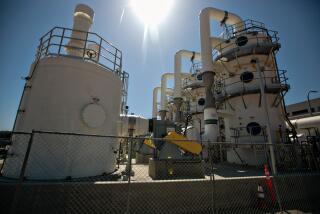Drinking Water on Airlines Is Dicey, EPA Says
WASHINGTON — The drinking water on more than one of every eight passenger airliners tested by the Environmental Protection Agency flunked the agency’s standards for bacteria, the government said Monday.
EPA officials said they had no evidence that airline passengers had gotten sick from airplane water. But the agency said in a statement: “Passengers with compromised immune systems or others concerned [about the safety of the water] may want to request canned or bottled beverages.”
Representatives of the leading airline industry trade group said they were confident that airline water was safe. “There are no reported cases of illnesses due to aircraft drinking water,” said Nancy Young, managing director of environmental programs at the Air Transport Assn.
But environmentalists said people might be getting sick from airplane drinking water without realizing the cause.
“That’s absurd to say nobody has gotten sick,” said Erik Olson, an attorney for the Natural Resources Defense Council. “How do they know?”
The EPA tested the water recently in 158 randomly selected airplanes at seven airports across the country. Some of the planes had flown foreign routes.
The water in 20 of the planes tested positive for total coliform bacteria, a contaminant that indicates disease-causing organisms can be present. The water in two of those aircraft also tested positive for E. coli., a bacterium that can cause acute gastrointestinal problems such as cramps, vomiting and diarrhea and, in extreme cases, can lead to death.
The EPA investigation followed one by the Wall Street Journal two years ago that came up with even more disturbing results. The Journal reported on Nov. 1, 2002, that it checked the water on 14 domestic and international flights and found bacteria levels on almost all the flights of tens to hundreds of times above government standards.
The contaminants included not only salmonella and staphylococcus but also insect eggs and a bacterium primarily carried by rodents.
Most airplanes have one water supply that is used for lavatories and the galley. The water is used for coffee and tea, and sometimes drinking water. Airlines refill their water tanks at domestic as well as foreign airports.
The EPA said its findings were preliminary and more tests were needed to know the extent of the risk to passengers. But the agency is already working with the airlines to determine how to fix the problem. Airlines could be required to increase how frequently they disinfect their water storage tanks or more rigorously test the water in their tanks or the water they take on at airports, EPA officials said.
“We’re interested in protecting the traveling public,” said Ben Grumbles, acting assistant EPA administrator for water.
Officials of the Air Transport Assn. said the airlines would work with the agency but disputed the EPA’s findings. Two recent studies, one by the Air Transport Assn. and another by the Food and Drug Administration, found airline water free of contaminants that could pose health risks, Young said.
The EPA’s testing methods may have caused misleading results, he added, because most of the samples were taken from lavatory faucets and could have been contaminated from the lavatories.
Tom Skinner, who heads the EPA enforcement office, rejected that possibility. “I have all the confidence in the world in our folks and their ability to take samples,” he said.
Skinner said contaminated airline water did not pose an imminent health crisis. “We want to make sure we have a fully informed public that can make educated decisions when they fly,” he said.
Olson, the environmentalist, was particularly disturbed by EPA’s finding that there was no presence of chlorine in many of the samples.
He said that could indicate that the water storage systems were not being cleaned frequently enough to prevent harmful bacteria from remaining in water supplies.
“If you’re not routinely maintaining that plane, you can have an ongoing contamination problem,” Olson said.
More to Read
Get the L.A. Times Politics newsletter
Deeply reported insights into legislation, politics and policy from Sacramento, Washington and beyond. In your inbox three times per week.
You may occasionally receive promotional content from the Los Angeles Times.










